Solana faces fierce competition from the Ethereum L2 space and must defend its reputation as one of the fastest and most performant blockchains in the world against a new wave of challengers.
Written by: Charles Yu, Galaxy
Translated by: Bai Shui, Jinse Finance
Overview
Solana is a high-performance, low-latency blockchain known for its speed, efficiency, and focus on user experience. Despite initially facing recurring network outages and being closely associated with FTX, Solana has made a significant recovery and found a strong ecological foothold in payments, DePIN, mobile, and consumer terminal markets. Looking ahead, Solana faces fierce competition from the Ethereum L2 space and must defend its reputation as one of the fastest and most performant blockchains in the world against a new wave of challengers.
Background Information
Solana was launched by Solana Labs in 2020, which was founded by Anatoly Yakovenko ("Anatoly") and Raj Gokal in 2018. Anatoly, who previously worked in systems engineering at Qualcomm, set out to build a blockchain optimized for information throughput and speed to address the scalability issues faced by Ethereum—specifically, "a state machine that synchronizes globally with the lowest possible latency," Anatoly said.
The core principles that distinguish Solana from other blockchains include:
- Prioritizing hardware-based scalability advantages. By maximizing the efficiency of cores, disks, and network cards, Solana aims to elastically scale over time with hardware improvements.
- Achieving consensus faster through time. Solana combines the Proof of History (PoH) consensus mechanism with the more common Proof of Stake to quickly synchronize state with minimal indirect costs.
- Achieving composability through an integrated (monolithic) architecture. As a unified ecosystem, all applications built on this single blockchain inherit composability, allowing them to interact and build on each other seamlessly.
Other defining features of Solana include:
- Fast transaction confirmations. Solana aims for a slot time of 400 milliseconds, but typically falls between 500-600 milliseconds (see Solana Explorer). Unlike Ethereum, Solana does not have a native protocol-level memory pool; instead, user transactions are routed directly to validators, which can speed up execution and shorten confirmation times.
- High throughput and scalability through parallelization. Solana's theoretical throughput is 65k TPS, and it employs a multithreaded approach to achieve parallel transaction execution (the Solana Virtual Machine (SVM) is designed to process multiple transactions in parallel by utilizing all cores of validator machines).
- Cheap, predictable transaction fees. Network fees on Solana are fixed at 0.000005 SOL per transaction (approximately $0.00025 per transaction on average); the local fee market (related to parallel processing) can prevent a specific activity on the network from increasing fees across the entire network.
- High costs of running validator nodes. Solana validators have high requirements for nodes, and operational costs are significant, including hardware costs (e.g., CPU > 16 cores / 32 threads; 512GB RAM or more; 1TB SSD or more), on-chain voting fees associated with each validation block (up to about 1 SOL/day), server costs (estimated at $500 per month), and bandwidth (minimum 1GB/s download/upload speed, preferably 10GB/s commercial speed). These operational costs for running a Solana validator are estimated to total around $50,000 per year.
Note: To enhance the decentralization of the network, the Solana Foundation Delegated Program (SFDP) has taken on part of the voting costs for participating validators. Helius estimates that if the SFDP were to stop immediately, about 900 participants in the program (about 57% of all Solana validators) would struggle to maintain profitable operations.
Over the years, Solana's unique blockchain design and fee market approach have led to periodic outages or performance degradation. While the specifics of each outage may vary, most issues are related to network congestion caused by spam transactions (facilitated by Solana's cheap fixed fee structure). During these congestion periods, the failure or loss rate of transactions for Solana users is high, leading to a poor user experience.
These issues have prompted the network to implement solutions, including (i) optional priority fees to increase the likelihood of transaction acceptance, (ii) the local fee market mentioned above, and (iii) QUIC and stake-weighted QoS (Quality of Service), which work together to improve communication between nodes and allow block producers to prioritize traffic on the network. After these changes, the network's stability has significantly improved—only one incident has been reported since the last event in February 2023.
Additionally, as a long-term solution, it will significantly enhance Solana's performance during congestion. Jump Crypto has been leading the development of a new validator client called Firedancer, written in C++. The Firedancer client leverages a unique modular architecture by completely rewriting the functional components of the network, runtime, and consensus. Firedancer has proven capable of processing over 1 million transactions per second (more than 10 times Solana's current theoretical maximum of 65k TPS), promising to provide future-proofing for the Solana network and solidifying its status as "the fastest blockchain in the world." Firedancer will also lower hardware requirements, making it cheaper to run new validators on Solana and increasing the network's resilience by introducing another validator client to run alongside the existing Rust-based Agave client. At Solana's Breakpoint conference in September 2024, Jump's chief scientist announced that "Frankendancer" (a temporary non-voting version of the full Firedancer client) has gone live on the mainnet, and the Firedancer client has been launched on the testnet (the runtime and consensus components of the full Firedancer client are still under development). The specific date for the Firedancer mainnet release has not been determined but is expected sometime in 2025.
Ecosystem Highlights
The Solana network and its community were particularly affected by the collapse of FTX in early November 2022, due to the ecosystem's ties to FTX and its CEO Sam Bankman-Fried, who was an early supporter of the protocol and an investor in many ecosystem projects. Since then, Solana's adoption has gradually but steadily rebounded, especially by the end of 2023. Today, Solana boasts a rich project ecosystem covering several noteworthy verticals, including:
Retail (Meme Coins / NFTs). With meme coins and NFTs having viral spread and astronomical profit potential, they have attracted a new wave of retail users on Solana. Solana has a robust ecosystem of launchpads, marketplaces, and community engagement tools. Creators of meme coins and NFTs on Solana can easily mint new tokens at very low deployment costs using tools like Pump.fun or Metaplex. Solana leads all other blockchains in token issuance, many of which are meme coins, such as dogwifhat (WIF), Bonk (BONK), Jeo Boden (BODEN), and Moo Deng (MOODENG). Additionally, Solana's state compression allows NFT creators to batch mint NFTs through Metaplex at a much lower cost compared to using Ethereum.
Payments. Solana Pay aims not just to "pay with cryptocurrency" but to usher in a new era of payments and commerce. Solana enables users to pay merchants with almost instant confirmations, with the lowest and most predictable fees. Solana Pay can be used as an integrated plugin option in Shopify-supported storefronts. Solana has gained recognition from Circle, Visa, and PayPal for stablecoin settlements. In particular, in the "In-Depth Study of Solana" report, Visa highlighted Solana's high throughput, its multithreaded approach supporting parallel transaction execution, the low and predictable transaction fees of the localized fee market, and near-instant transaction confirmations.
At the beginning of 2024, Paxos, which issues stablecoins including USDP and PayPal's PYUSD, received regulatory approval from the New York State Department of Financial Services (NYDFS) to offer its products on Solana, making it the second blockchain after Ethereum to do so. Previously, trusts like Paxos regulated by the NYDFS were limited to issuing on Ethereum.
DePIN ("Decentralized Physical Infrastructure"). Solana has a rich ecosystem of DePIN ("Decentralized Physical Infrastructure") projects. DePIN leverages the financial infrastructure of cryptocurrency and token incentives to build a fair physical infrastructure network that facilitates the distribution of ownership. Projects like Helium, Hivemapper, and Render recognize Solana's technological advantages, which enable DePIN infrastructure to be deployed at scale and at low cost, allowing developer/user communities to support and iterate on it—both Helium and Render migrated from other chains to Solana in 2023, highlighting the strong network infrastructure, developer tools, and distribution capabilities of Solana as reasons for the migration.
Solana Mobile. Solana Mobile is a subsidiary of Solana Labs that offers Android phones designed specifically for Web3, along with its own free Solana dApp Store. The Saga phone was officially launched in May 2023 at a price of $1,000, initially with limited demand but quickly sold out all 20,000 units produced, thanks to a discounted price of $599 and additional financial incentives from third-party ecosystem projects (i.e., the coveted BONK airdrop for Saga purchasers, which exceeded the initial cost of the phone). As of September 2024, pre-orders for the new $450 Seeker phone (the successor to Saga) have exceeded 140,000 units, with plans for a mid-2024 release. Similarly, at this year's Solana Breakpoint, Jambo announced the launch of JamboPhone 2, another Android phone integrated with Solana, priced at just $99.
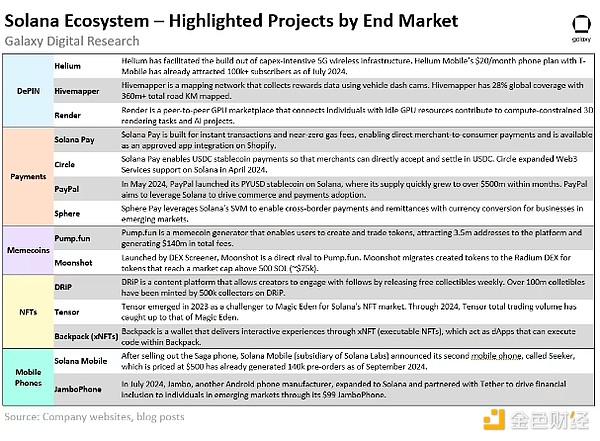
The new tools launched this year have empowered project teams on Solana to accelerate the adoption and growth of the aforementioned core terminal markets.
- Blinks/Actions. In June 2024, Solana launched Actions and Blinks (short for "Blockchain Links"), which easily integrate blockchain transactions into any platform, creating a seamless and intuitive experience for users. Actions are APIs that prompt applications to send signable transactions to users in various environments (such as QR codes, buttons + widgets on mobile and desktop applications, and websites). Actions enhance the accessibility of Web3 applications, reduce user friction, and simplify the process of integrating on-chain transactions into existing websites or applications. Examples of Actions usage include facilitating face-to-face retail payments with cryptocurrency via QR codes or integrating blockchain functionality into gaming platforms for in-game market transactions, while Blinks can be used to tip content creators through social media without complex wallet setups.
- Token Extension. At the beginning of 2024, Token Extension (formerly known as Token-2022) was launched as a new Solana token program with rich native features, providing advanced tools including confidential transfers, transfer fees, and permissioned access to meet the needs of regulated enterprises and institutions. Token Extension unlocks new use cases, including interest accumulation on yield-bearing assets or governance for RWA issuance. Stablecoin issuers, including Paxos, have already implemented Token Extension, leveraging features such as permanent delegation, metadata pointers, and transfer hooks.
SOL Token / Token Economics
User transaction fees on Solana include:
- Network transaction fees or "base fees" are fixed (unlike Ethereum's variable base fees), charged at a fixed rate of 0.000005 SOL (5,000 "lamports") per signature.
- Priority fees (implemented in 2023) are optional payments used to combat network spam and accelerate transaction speeds to increase the likelihood of inclusion in blocks. Priority fees are a function of the computational requirements for transaction processing. Since the rise of memecoin activity on Solana at the end of 2023, priority fees have rapidly grown to become the largest component of Solana's total transaction fees, averaging over 80% of total transaction fees by 2024.
In addition to paying the base fees for user-initiated transactions, validators participating in consensus must also submit on-chain voting transactions for each proposed block, incurring the same fixed fee rate of 0.000005 SOL as the base fee. Voting costs can increase to about 1 SOL per day or approximately 300-350 SOL per year, which constitutes a major operational cost for validators.
Currently, 50% of all transaction fees on Solana (including base fees, priority fees, and voting fees) are burned. The remaining 50% goes to the current leader of the proposed block.
Looking ahead, the reward distribution structure will soon change with SIMD-0096 (approved by Solana governance in May 2024), allowing block producers to retain 100% of the priority fees.
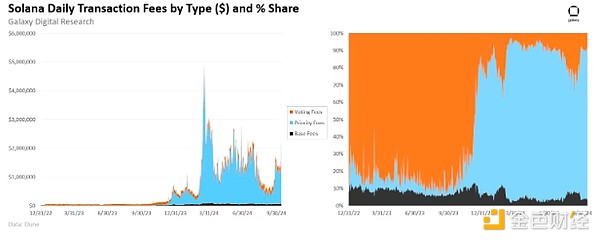
As mentioned earlier, the annual operational cost of running a validator on Solana is approximately $50,000. Validators generate revenue through (i) inflation commissions, (ii) block rewards, and (iii) MEV (primarily through running the Jito client). Priority fees have historically aligned with Jito Tips, although during periods of active economic activity, Jito Tips often exceed priority fees. However, since validators only received 50% of the profits from priority fees before SIMD-0096 (as 50% were burned), MEV has become a more significant source of income for validators.
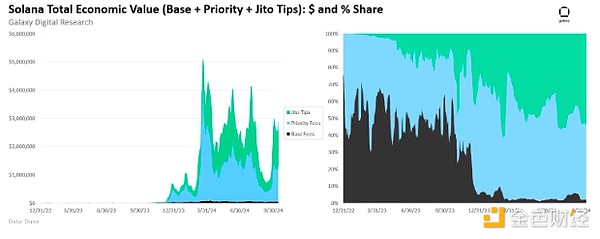
Other Token Details:
- Token Inflation: The inflation rate for SOL was initially set at 8% and will decrease by 15% each year until it reaches a long-term inflation rate of 1.5%. There is theoretically no supply cap, but without considering the impact of token burns, the SOL supply is expected to grow to approximately 737 million by the end of 2030 (an increase of 110 million from current levels, or a future inflation rate increase of 3.0% over the next six years).
- Staking: As of October 15, 2024, 83.9% of the circulating SOL supply has been staked, with 88.4% running Solana Labs or Jito-Solana clients and earning MEV rewards. There are 1,328 staking validators, with an average staking balance of 325 SOL, valued at approximately $50,000 (however, the top 19 nodes hold 33% of the total staking balance). The current annual interest rate for stakers is 6.3%.
- Unlocking: Following significant cliff unlocks to private investors and the foundation in January 2021, and the completion of team unlocks in January 2023, there are no other programmatic unlocks for the SOL supply beyond the standard inflation paid to stakers.
Note: Some non-circulating or staked supply may be locked (e.g., as a result of investments in SOL or grants from the Solana Foundation) or subject to bankruptcy proceedings. Other portions of the non-circulating supply may be held by Solana Labs or the foundation for their delegation programs, where staking is delegated to over 1,000 validators to improve decentralization.
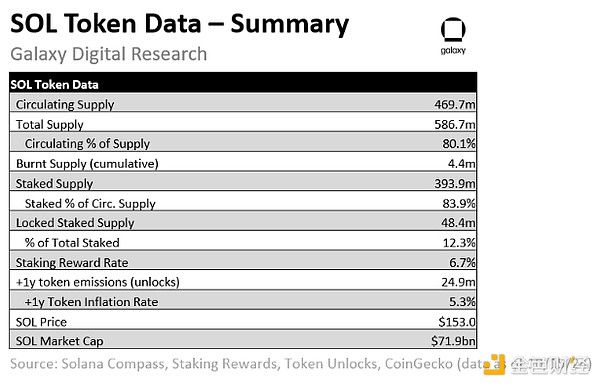

Key Metrics
- Since voting transactions are conducted on-chain and each validator votes on every slot (producing over 2k votes per second), non-voting transactions should be viewed as a better representation of Solana user activity.
- Voting fees should also be excluded from the calculation of Solana's total economic value, which is the sum of base fees, priority fees, and Jito Tips (as shown in the previous section).
- The sources of Solana fees represent the network's development. Priority fees have grown to account for over 75% of total network fees, surpassing base fees and voting fees (as shown in the previous section). Monitoring the volatility and growth of network transaction fees from non-voting transactions is crucial; so far, by 2024, the average fee for non-voting transactions is $0.017.
- While Solana's infrastructure has improved uptime in recent years, transaction failures and losses on Solana remain a common issue. The transaction failure rate has decreased from peaks in March and April of this year, when the failure rate for non-voting transactions averaged over 60%. However, it is worth noting that most of the failure rate is attributed to spam transactions from MEV bots.
- The income of Solana validators is crucial for monitoring the foundation's spending on delegation programs. Many Solana validators cannot cover high operational costs and require subsidies from the foundation. Even as Solana's economic activity has recovered in 2024, native issuance rewards account for over 80% of the total staking rewards for validators. The foundation currently subsidizes about 50 million SOL to 1,100 validators (about 70% of total validators), indicating that if the foundation were to stop the delegation program, most validators would be unable to operate profitably.
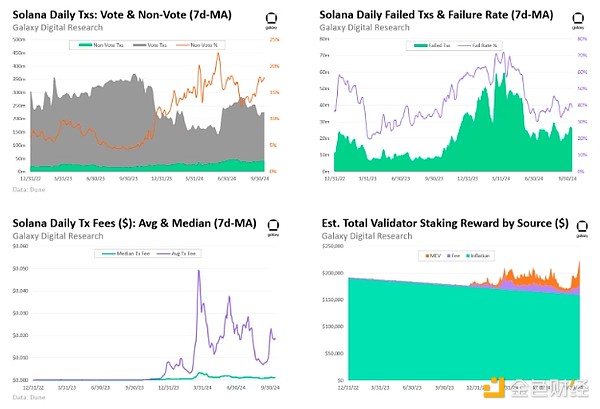
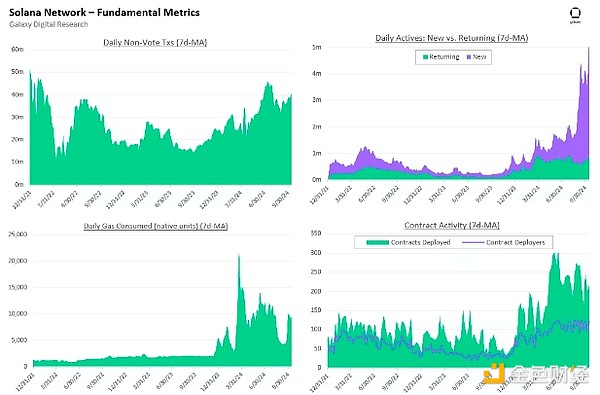
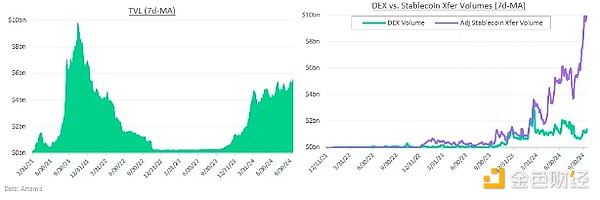
Competitive Positioning
Solana's main competitors categorized include:
- The debate between "Modular vs. Integrated Blockchains" involving Ethereum and L2 integrated blockchains. The Ethereum ecosystem is vying for a technological edge through its modular approach, benefiting from a rich ecosystem of project teams, each focused on optimizing a specific infrastructure component. While most of the Solana community condemns L2 and application chains, some builders are attempting to combine aspects of both approaches (e.g., by launching rollups (RollApps) on Solana or launching SVM-driven L2s on Ethereum), blurring the competitive boundaries between the two networks.
- Consumer and payment-focused blockchains (e.g., memecoins and NFTs): Base is the second most popular memecoin trading platform, Tron is one of the most commonly used payment platforms, and the TON blockchain adopts a mobile-centric approach to attract retail users (competing with Solana's Saga and Seeker phones).
- Other high-performance, fast blockchains. Solana is experiencing increasingly fierce competition from other blockchains that adopt similar approaches to optimize speed and employ similar core design elements, such as parallel transaction processing. This list includes Move-based chains (like Aptos and Sui), Sei (the first parallel EVM blockchain), and emerging chains promising sub-second latency and > 100k TPS throughput (like Monad and MegaETH). It is also worth noting that Solana's block time (averaging 0.45 seconds) lags behind the block times on Aptos, Arbitrum, and Sei (ranging from 0.21 seconds to 0.41 seconds for that group).
Future Challenges / Opportunities:
- Expanding to new payment processes. Payments on Solana can serve as a gateway to business experiences supporting web3 (e.g., token-gated offers, NFT-based loyalty programs, and airdrop rewards for new customers to enhance engagement). While Solana has been praised for its payment viability by companies like PayPal, Shopify, and Visa, we have yet to see strong evidence of the network (or any other blockchain) adopting business-based payments. These companies aim to leverage crypto payment rails to drive widespread adoption of new use cases, so their partnerships with Solana could help drive significant economic activity on the network.
- Maintaining/accelerating momentum in the DePIN vertical. DePIN is one of the most notable and potentially transformative use cases for blockchain technology. The two largest DePIN projects, Hivemapper and Helium, migrating to Solana have attracted other projects that also leverage Solana's technology and ecosystem. That said, due to lower entry barriers and the emergence of imitators/forks on alternative platforms, Solana must act quickly to consolidate its leadership position if it wants to dominate the emerging DePIN market.
- Converting first-time memecoin cryptocurrency users into lifelong loyal Solana users. Memecoins have been a powerful user acquisition channel for Solana. They attract a new wave of cryptocurrency users, teaching them how to self-custody and how to submit (and resubmit) transactions by increasing priority fees or adjusting slippage settings to enhance the chances of success. Memecoins complement DeFi activity, but given the low retention rates over longer time frames and limited user engagement, there is an opportunity to convert first-time cryptocurrency users from memecoins into loyal lifelong Solana users. For example, dedicated mobile strategies using the new Seeker and JamboPhone 2 can leverage Solana Actions/Blinks to drive user engagement on Solana.
- Increasing institutional adoption and regulatory acceptance. Although Anatoly's slogan is "the blockchain at Nasdaq speed," Solana has been relatively slow in institutional adoption among TradFi brands. However, the Token Extension was only launched in early 2024, and Paxos has adopted them to enhance the token standards for PYUSD and USDP. Additionally, the NYDFS granted regulatory approval to Paxos, expanding its stablecoin issuance to Solana, making it the second chain after Ethereum, indicating increasing regulatory acceptance of the network.
- Realigning the fee structure and improving validator economics. Past technical upgrades (including priority fees and stake-weighted QoS) have redistributed network resources to address transaction failure rates and network downtime issues. However, these solutions have not been fully effective in preventing spam transactions. Since base fees account for only a small portion of total transaction fees, there is room for them to increase from the current level of 0.000005 SOL, which could also alleviate the profitability challenges of operating validators. Hardware improvements and the upcoming Firedancer should also reduce the costs of running validators. Therefore, the Solana Foundation may reallocate financial resources from its authorization program specifically for various ecosystem initiatives in the aforementioned verticals.
- Convincing project teams to launch on Solana > launching application-specific chains. Ethereum L2 and Cosmos provide developers with rich development tools and the ability to customize application-specific chains to meet user-specific needs. These solutions attract project teams to launch their rollups to gain benefits such as reduced block space competition and better control over the economic value generated by users. Solana must convince project teams that an overall/integrated chain has technical and social benefits compared to launching application-specific chains/L2s, which today face fragmentation and a lack of composability.
- Withstanding emerging "Solana killers" and maintaining the title of "the world's fastest/highest-performing blockchain." While Ethereum is Solana's main competitor, a wave of "next-generation" blockchains is beginning to emerge, targeting Solana. These newer chains adopt different approaches to optimize various system components to provide the same speed and throughput advantages currently offered by Solana. Solana will maintain its lead over these emerging competitors by nurturing its community, retaining its existing user base, and releasing technological improvements like Firedancer to uphold the title of "the world's fastest blockchain." However, it is worth noting that after pushing to the mainnet, the network will still be limited by downstream network capabilities and QUIC. Unless 100% of validators upgrade to Firedancer, its maximum impact on the network cannot be realized, and if they all upgrade, the benefits of "multi-client" will not be achieved.
Upcoming Significant Events/Progress
Some important upcoming events/progress and expected timelines:
- Complete Firedancer client (expected 2025)
- Solana L2, SVM rollups, Solana re-staking, and ZK compression (2024-2025)
- 2025 Abu Dhabi Solana Breakpoint (December 2025)
免责声明:本文章仅代表作者个人观点,不代表本平台的立场和观点。本文章仅供信息分享,不构成对任何人的任何投资建议。用户与作者之间的任何争议,与本平台无关。如网页中刊载的文章或图片涉及侵权,请提供相关的权利证明和身份证明发送邮件到support@aicoin.com,本平台相关工作人员将会进行核查。




